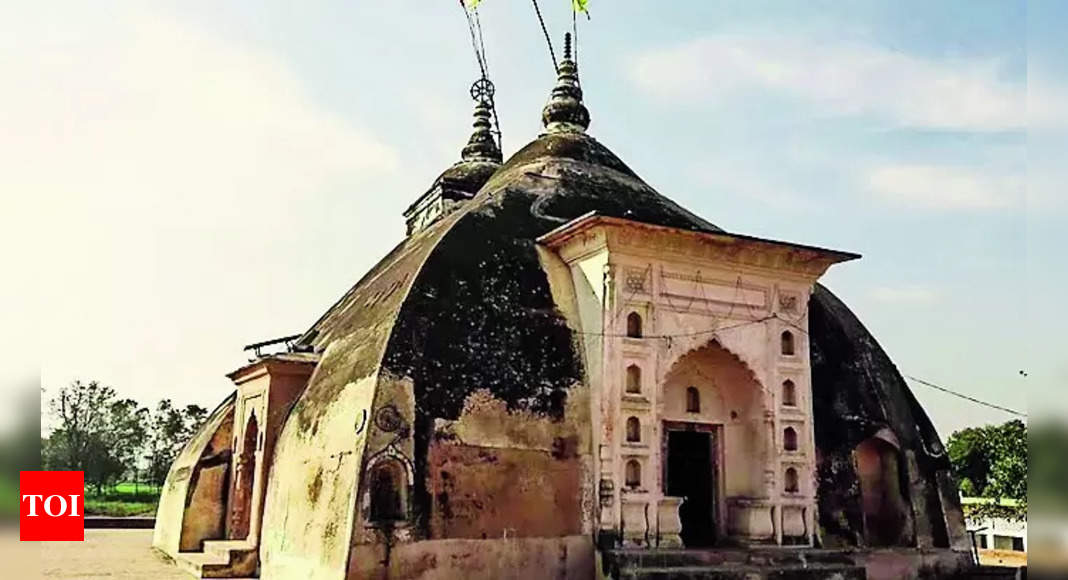
KANPUR: Belief often blurs the lines of reason. In Kanpur’s ancient Jagannath temple, famous for predicting arrival and extent of monsoon with surprising exactitude, it’s an annual tradition. A team from the meteorological department of Kanpur’s Chandra Shekhar Azad University of Agriculture and Technology that visited the temple on Sunday has predicted heavy rain in the city this season.
Situated at Behta Bujurg village, the 11th century temple – with a parabolic dome similar to those found in the temples of West Bengal and Odisha – is steeped in mystique and has baffled scholars over the centuries. According to temple priest KP Shukla, a stone slab in the ceiling of the temple’s sanctum sanctorum starts dripping days before the onset of monsoon.
“This year, big drops are falling from the temple’s ceiling quite frequently. Hence, it is believed that the rain will be good,” said agri weather scientist SN Sunil Pandey who led the team.
Pandey said that this time, the temple’s ceiling began to drip at the same time when the monsoon entered Kerala.
The farming community residing in a radius of 50 to 60 km around Behta Bujurg temple is heavily dependent on the prediction of Jagannath temple. “They have started flocking the temple to check the rainfall for the year and make their agricultural preparations and decisions for the season. As the water droplets have started accumulating on the ceiling, they have been organising special prayers expecting a good yield,” said Prakash Singh, a local villager.
Archaeologists and scientists have visited the temple to understand the phenomenon, but so far, the exact reason for accumulation of water droplets on the sanctum sanctorum’s ceiling remains a mystery. According to villagers, once the monsoon sets in, the water droplets vanish, and the ceiling of the temple becomes dry.
The temple at Behta has a Rath Yatra and a huge festival every year in July that coincides with the Rath Yatra in Puri. The sleepy village with a population of barely a few hundreds is suddenly filled with devotees coming in from various parts of the state that time of the year.
Situated barely five kilometres from the temple of Bhitargaon, the oldest surviving brick temple in India, at Kanpur’s Ghatampur tehsil, the temple of Behta Bujurg was first mentioned by British archaeologist Alexander Cunningham, the founder of ASI, in 1876-77, when he visited the region. When writing about the Bhitargaon Dewal, which is believed to be dated 5th century AD, Cunningham called the temple at Behta of a “much later date”.
It is situated in a region that is abundant with ancient temples.
Situated at Behta Bujurg village, the 11th century temple – with a parabolic dome similar to those found in the temples of West Bengal and Odisha – is steeped in mystique and has baffled scholars over the centuries. According to temple priest KP Shukla, a stone slab in the ceiling of the temple’s sanctum sanctorum starts dripping days before the onset of monsoon.
“This year, big drops are falling from the temple’s ceiling quite frequently. Hence, it is believed that the rain will be good,” said agri weather scientist SN Sunil Pandey who led the team.
Pandey said that this time, the temple’s ceiling began to drip at the same time when the monsoon entered Kerala.
The farming community residing in a radius of 50 to 60 km around Behta Bujurg temple is heavily dependent on the prediction of Jagannath temple. “They have started flocking the temple to check the rainfall for the year and make their agricultural preparations and decisions for the season. As the water droplets have started accumulating on the ceiling, they have been organising special prayers expecting a good yield,” said Prakash Singh, a local villager.
Archaeologists and scientists have visited the temple to understand the phenomenon, but so far, the exact reason for accumulation of water droplets on the sanctum sanctorum’s ceiling remains a mystery. According to villagers, once the monsoon sets in, the water droplets vanish, and the ceiling of the temple becomes dry.
The temple at Behta has a Rath Yatra and a huge festival every year in July that coincides with the Rath Yatra in Puri. The sleepy village with a population of barely a few hundreds is suddenly filled with devotees coming in from various parts of the state that time of the year.
Situated barely five kilometres from the temple of Bhitargaon, the oldest surviving brick temple in India, at Kanpur’s Ghatampur tehsil, the temple of Behta Bujurg was first mentioned by British archaeologist Alexander Cunningham, the founder of ASI, in 1876-77, when he visited the region. When writing about the Bhitargaon Dewal, which is believed to be dated 5th century AD, Cunningham called the temple at Behta of a “much later date”.
It is situated in a region that is abundant with ancient temples.





